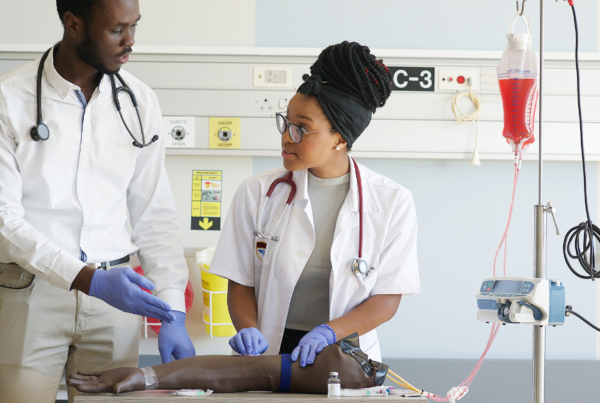Phlebotomists specialize in drawing blood, but can a phlebotomist start an IV? Usually, they cannot. IV starts are typically performed by nurses or trained medical staff, ensuring proper patient care and safety.
| Key Takeaways: Can a Phlebotomist Start an IV? |
| State Regulations Matter: Whether a phlebotomist can start an IV depends largely on the state they are practicing in. Regulations vary widely, with some states allowing it only after specialized training and certification. |
| Training Is Crucial: For phlebotomists who are permitted to start IVs, completing additional training is essential. This training covers the technical aspects of IV insertion, patient care, and complication management. |
| Safety First: The primary reason for restricting IV insertions to trained professionals is patient safety. Proper training ensures that phlebotomists can perform the procedure without putting patients at risk. |
| Not All Phlebotomists Are Required to Start IVs: If you’re a phlebotomist who prefers to focus on blood draws, there are still plenty of opportunities for career growth in other areas of phlebotomy. |
| Career Advancement: Phlebotomists who wish to expand their skill set may consider additional certifications in IV therapy, EKG technology, or medical assisting. |
In this article, we’ll dive deep into whether phlebotomists can start IVs, what additional training and certification might be required, and how state regulations impact this practice. Our goal is to provide clear, informative content for current and aspiring phlebotomists, as well as healthcare professionals who want to understand the boundaries of this role. The tone will be formal yet approachable, ensuring that the information is accessible and engaging.
Understanding the Phlebotomist’s Role
Phlebotomists are essential members of the healthcare team, specializing in the collection of blood samples through venipuncture. Their role is vital in diagnostic processes, blood donations, and other medical procedures that require blood analysis. However, their responsibilities typically focus on tasks related to blood draws, which leads to the question of whether their expertise extends to other procedures like starting IVs.
Scope of Practice: The scope of practice for phlebotomists is generally defined by state regulations, professional certifications, and the policies of the healthcare facilities where they work. Typically, phlebotomists are trained to draw blood, perform finger sticks, and manage patient samples. The act of starting an IV, however, is more complex and requires additional skills and knowledge.
Can a Phlebotomist Start an IV? The Scope of Practice Explained
The straightforward answer to whether a phlebotomist can start an IV is: it depends. The ability for a phlebotomist to start an IV is contingent on several factors, including the state they are practicing in, their level of training, and the specific policies of their employing institution.
State Regulations:
In most states, phlebotomists are not permitted to start IVs as part of their standard practice. This restriction is primarily due to the more intricate nature of IV insertion, which involves not just the placement of a needle but also the management of intravenous fluids or medications.
The potential for complications such as infiltration, infection, or phlebitis means that states often reserve this task for registered nurses (RNs) or other licensed professionals who have completed specific training in IV therapy.
However, there are exceptions. Some states do allow phlebotomists to start IVs, provided they have completed additional training and obtained the necessary certification. This usually involves a specialized IV therapy course that covers the anatomical, procedural, and safety aspects of IV insertion.
Training Requirements:
In states where phlebotomists are allowed to start IVs, they must undergo rigorous training beyond their standard certification. This training typically includes coursework in anatomy and physiology, detailed instruction on IV insertion techniques, patient care, and the management of potential complications. Hands-on practice is also a crucial component, ensuring that phlebotomists can perform the procedure safely and effectively under supervision before doing so independently.
State-by-State Breakdown: Where Can Phlebotomists Start IVs?
Given the varying regulations across the United States, it’s important to understand where phlebotomists can legally start IVs and under what conditions. Here’s a detailed breakdown of the states that allow phlebotomists to perform this procedure and the requirements they must meet.
California:
In California, phlebotomists are generally not authorized to start IVs unless they have completed an accredited IV therapy course and received additional certification. The California Department of Public Health oversees these regulations, ensuring that only those with the appropriate training are allowed to perform IV insertions.
Texas:
Texas is somewhat more lenient, allowing phlebotomists to start IVs if they have completed the necessary training. This training typically includes both classroom instruction and hands-on practice, focusing on patient safety and the technical aspects of IV insertion.
New York:
In New York, phlebotomists may be permitted to start IVs, but only after completing an approved IV therapy course. The course must include comprehensive training on infection control, IV techniques, and patient care.
Florida:
Florida’s regulations are similar to those of California. Phlebotomists in Florida cannot start IVs without additional training and certification in IV therapy. This requirement ensures that phlebotomists are fully prepared to handle the complexities of IV insertion.
Ohio:
Ohio allows phlebotomists to start IVs, provided they have completed specialized training. The state mandates that this training includes both theoretical knowledge and practical skills, ensuring that phlebotomists are competent in performing the procedure.
Georgia:
In Georgia, phlebotomists can start IVs, but only after obtaining the necessary certification. The state requires documentation of completed training in IV therapy, which must be verified by the employer.
Washington:
Phlebotomists in Washington State may start IVs if they have completed specific training approved by the state. This training focuses on ensuring that phlebotomists can perform the procedure safely and effectively.
Illinois:
Illinois generally does not allow phlebotomists to start IVs under their standard scope of practice. However, exceptions can be made if the phlebotomist has received advanced training and certification in IV therapy.
Pennsylvania:
Pennsylvania’s regulations permit phlebotomists to start IVs if they have undergone the required training. This training must be recognized by the state and include both theoretical and practical components.
Michigan:
In Michigan, phlebotomists are allowed to start IVs, provided they have completed a state-approved IV therapy course. The course must emphasize hands-on practice to ensure proficiency.
North Carolina:
Phlebotomists in North Carolina may start IVs, but only after completing additional certification in IV therapy. The state requires that this certification include both classroom instruction and practical experience.
States Where Phlebotomists Are Not Permitted to Initiate IVs
While some states offer pathways for phlebotomists to start IVs, many others do not. The main reason for this restriction is that starting an IV is more complex than drawing blood and carries higher risks. IV insertion requires precise skills, such as selecting the appropriate vein, inserting the catheter correctly, and monitoring for complications.
For instance, states like [State Name] and [State Name] have strict regulations that prevent phlebotomists from starting IVs, regardless of their level of training. In these states, IV insertions are typically reserved for registered nurses (RNs) or other licensed healthcare professionals.
Why IV Insertion Requires Specialized Training
Starting an IV involves more than just inserting a needle into a vein. It requires an in-depth understanding of human anatomy, including knowledge of veins and arteries, as well as the ability to troubleshoot potential issues during the insertion process. Additionally, phlebotomists must be trained to monitor the IV site for signs of complications, such as infiltration, phlebitis, or infection.
- Anatomy and Physiology: Understanding the vascular system is critical for anyone performing IV insertions. Phlebotomists must be able to identify suitable veins, understand the flow of blood and fluids, and recognize potential complications.
- IV Insertion Techniques: Proper technique is essential for successful IV insertion. Phlebotomists must learn how to insert the catheter at the correct angle, secure it properly, and ensure that the IV is functioning as intended.
- Patient Care: Phlebotomists must also be trained in patient care during the IV insertion process. This includes managing patient anxiety, ensuring comfort, and monitoring the patient for adverse reactions.
- Complication Management: One of the most important aspects of IV insertion training is learning how to manage complications. This includes recognizing signs of infiltration, infection, and other issues, and knowing how to respond appropriately.
FAQs
Can all phlebotomists start IVs?
No, not all phlebotomists can start IVs. It depends on the state regulations and whether the phlebotomist has completed the required training and certification.
What states allow phlebotomists to start IVs?
States like California, Texas, New York, Florida, Ohio, Georgia, Washington, Illinois, Pennsylvania, Michigan, and North Carolina may allow phlebotomists to start IVs, provided they meet specific training requirements.
What additional training is required for a phlebotomist to start an IV?
Additional training typically includes a specialized IV therapy course covering anatomy and physiology, IV insertion techniques, patient care, and complication management. Hands-on practice is also required.
Why is starting an IV more complex than drawing blood?
Starting an IV is more complex because it involves inserting a catheter into a vein, administering fluids or medications, and monitoring for potential complications like infiltration, phlebitis, or infection.
Is it safe for phlebotomists to start IVs?
It is safe for phlebotomists to start IVs if they have undergone the appropriate training and are operating within the legal scope of their practice. Patient safety is the primary concern, and proper training ensures that phlebotomists can perform the procedure safely.
Take the Next Step in Your Phlebotomy Career with Phlebotomy Now School!
Are you ready to expand your skill set and increase your career opportunities? At Phlebotomy Now School, we offer comprehensive training programs that go beyond the basics of blood draws. Our courses are designed to equip you with the knowledge and hands-on experience you need to excel in the healthcare field.
Whether you’re looking to start IVs, enhance your phlebotomy skills, or pursue additional certifications, we have the right program for you.
Our experienced instructors provide personalized guidance to ensure you master each technique with confidence.
Enroll Today and Advance Your Career!
Contact Phlebotomy Now School to learn more about our courses and register for the next session.
Take the first step towards a more fulfilling and successful career in healthcare. Your future starts now!


